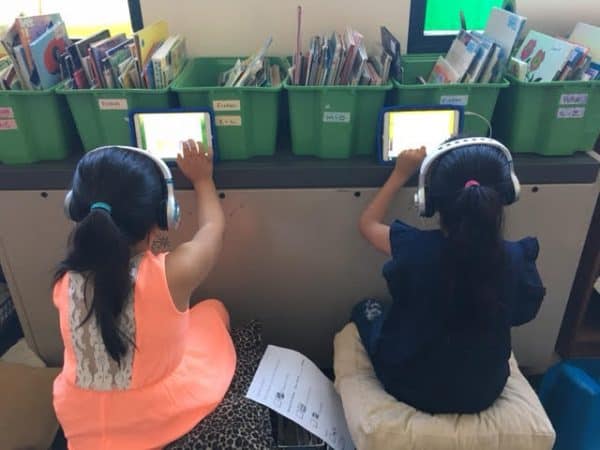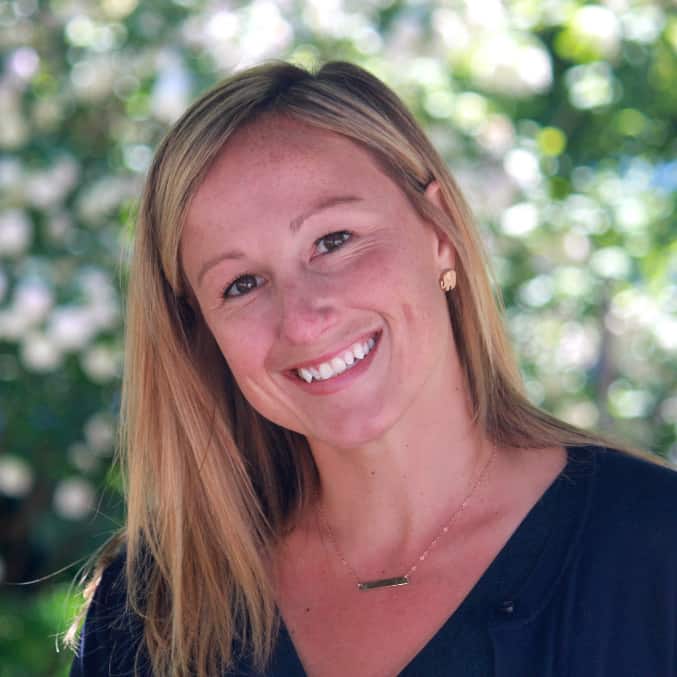Blended Learning Strategy: Small Groups and Stations
Common questions we hear about how to implement blended learning:
- How do we find time for small group instruction?
- How do you break up a big block?
- How do we leverage teacher talent?
- How do we use data to create groups?
Visiting three Bay Area school visits with some blended learning experts helped provide some answers to these questions and more.
 Oakland USD
Oakland USD
Redwood Heights Elementary in the Oakland Unified School District, has worked over the past couple of years to support innovation pilot classrooms. One of eight pilot sites, Redwood is a part of the Rogers Family Foundation goal to support at least 3,000 high quality, innovative, personalized, student-centered seats in Oakland by 2020.
Principal Cynthia Bagby-Ellison is a proponent of small group instruction (right) and values the time technology swap that blended learning makes possible. She also expressed that she feels much of their success so far has been due to a great deal of teacher and student agency.  Teachers had a great deal of say in what the pilots were in each classroom, so they created something that is truly theirs and that works for them (as a result, it is currently a collection of blended classrooms more than a single blended school model).
Teachers had a great deal of say in what the pilots were in each classroom, so they created something that is truly theirs and that works for them (as a result, it is currently a collection of blended classrooms more than a single blended school model).
Students in pilot classrooms transition seamlessly from small group instruction to computer-based stations. A certain portion of a student’s day is spent in each of the different stations, depending on the given task or learning goal for that student.
In one classroom, groups were gathered on the carpet and having a math talk about adding two-digit numbers; and in another were in a mini-lesson about a topic several  students needed review in.
students needed review in.
We saw students working in pairs to solve math problems and providing each other feedback about different ways they went about solving them.
Students were working together to tackle a playlist of “Have-To’s” and then move onto a choice activity. Part of a playlist might include an individualized program that progresses according to student readiness, such as ST Math.
We also visited Urban Promise Academy, a middle school in Fruitvale south of the airport. Like Redwood, a $350,000 grant sponsored implemented several blended learning pilots. The sixth grade team was selected to join Summit Basecamp and is benefiting from the Personalized Learning Plan (PLP) platform and training. It will be extended to seventh grade next year and become a whole school model.
Alpha Public Schools
Founded by John Glover in 2011, Alpha Public Schools aims to prepare students in low-income communities with the knowledge, skills and character traits they will need to succeed in college and career. The Alpha team focuses on five key areas:
- Strong relationships: Students develop strong ongoing relationships with their teacher who work closely with parents to educate and engage them as advocates for their child’s education.
- Personalized learning training: Quality development and leadership opportunities.
- Smart technology: Alpha leverages iXL, Newsela, Khan Academy, Discovery, BrainPop, and Reading Smart ESL and MAPS.
- Family college readiness: Students and teachers create, monitor and accomplish individualized learning goals.
- Computer science & design: Computer science is not just an elective, students all have the opportunity to engage in at least one computer science course.
- Career preparation: High expectation, opportunities for collaboration and job awareness are embedded in the school experience.
 Cindy Avitia High School is colocated with another charter school in the back lot of Overfelt High School in San Jose. While the humble modular settings (left) limit flexibility and integration opportunities, we saw great examples of blended learning.
Cindy Avitia High School is colocated with another charter school in the back lot of Overfelt High School in San Jose. While the humble modular settings (left) limit flexibility and integration opportunities, we saw great examples of blended learning.
Most of the high school classrooms shared a blended learning model (below) featuring five stations. (See Christensen Institute’s description of blended learning models.)
Students in freshman Computer Science (left) were actively discussing their computer science project with their teacher while three other groups worked independently.

Our freshman tour guide didn’t think a career in coding was for her but was glad to have had the exposure.
Students were using Google Docs to write in Spanish about what they thought of the book Caramelo.
Lessons
Both schools, while implementing their own version of blended learning, utilize some form of a station approach and a focus on small-group instruction as part of their solutions to these commonly asked questions. Principals from each school emphasized the importance of being versatile in the approach, but staying set on the vision of blended learning experiences for all students.
Jin-Soo Huh, Alpha’s Personalized Learning Manager, offered a few lessons learned about making the most of blended learning station rotation models:
- Practice routines. Stations only work if you are maximizing time in the stations. Make sure to get the transitions crisp so valuable instructional time is not lost.
- Regroup often. This is especially true if you have homogenous groups. Make sure to use assessments to regroup students often so they do not develop fixed mindsets around their abilities. You do not want students to think they are in the “dumb group” or the “smart group.”
- Personalize the stations. If students are doing the exact same activity at each station and the teacher is doing the exact same lesson with little modifications, it is probably easier and arguably more effective to just do whole group instruction. Adaptive online programs help take the planning burden off of teachers so students are able to get targeted practice.
- Data matters. Teachers are getting a ton of data from their in person interaction in small groups, online programs, and assessments. This can be overwhelming. Streamline this data by providing clear targets that students should be aiming for and give teachers and students feedback on their progress to these goals. This could be through data walls, progress reports, conferences, and more!
Greg Klein, Senior Director of Innovation and Learning at the Rogers Family Foundation, has been working with Redwood in the implementation of blended approach and also provided some valuable insights:
- Build student choice and agency over time. As needed, start with choices within a single station, and grow towards choices in each station. Eventually students can then make choices about which station to attend and for how long, and they can articulate how their choices lead to them accomplishing larger tasks and goals.
- Ask students to be accountable for their work. Support students to create their own station routines and means to stay on track with their own work.
- Ask students to be a part of the decision-making process. Care deeply about the various large deep tasks you want each student to be able to complete, and loosen up on the path any particular student takes to get to mastery. Ultimately, beginning of the year stations should yield to personalized pathways.
In contrast, Grant-Beacon Middle School in Denver (which we visited again last week) uses subject specific models: station rotation in math, project-based learning in social studies, and a flex model in ELA. A group of next-generation networks are developing models combining personalized and project-based learning.
The most challenging aspect of station rotation models is the often forgotten third part of the Christensen definition: “modalities along each student’s learning path within a course or subject are connected to provide an integrated learning experience.” Redwood Heights, Urban Promise, and Alpha teachers used data from adaptive computer-based stations to dynamically group students for small group teacher instruction to create a coherent and effective learner experience.
For more, see:
- Fulfilling an Urban Promise in Oakland
- Bay Blends Advance Personalized Learning
- Blended Learning Implementation Guide
Follow: @OUSDNews and @alphaschools
Stay in-the-know with all things EdTech and innovations in learning by signing up to receive the weekly Smart Update.




E Snider
This wildly underestimates the time it takes to make at least 5 different lesson plans for just one period. They have to be explicit, allowing students to follow independently, Time structured, consistent and yet wil be asked to both scaffold for students below grade level and have additional challenge for students that are gifted. Plus grading, and the investment of time and structure of the classroom itself. Not impossible but at the least so daunting it is not bought into by your average teacher without massive school support (not found frequently - just the $$ is not there most of the time.)
Replies
Tom Vander Ark
Thanks for your note. It does take more time than it should in many blended learning deployments to create a coherent learner experience. But the flip side is that 1) adaptive learning systems (i-Ready, DreamBox, ST Math) makes it easy to create a personalized experience for every student and 2) the data from those systems makes it easier to pull leveled groups.
Last week I visited two schools in the Summit Basecamp program and the teachers appreciated the ability to pull leveled groups and address real time needs. Students were able to make progress on their own by accessing learning playlists for the next topic they needed to learn.
Similarly, teachers in NewClassrooms.org classrooms are able to create lessons for small groups and know that every student will be ready for that lesson on that day and in that modality--the sort of conditions we should be creating for every teacher.
Larissa
I am more interested in HOW you do this. HOW do you set up various groups. I am being required to do this in my classrooms and I don't get HOW to go about it. Am I giving students different work to do based off of the whole group instruction? HOW do I put this in the grade book when different students are doing different assignments? Am I doing four different lesson plans per class? If so, when will I have time to do this, especially without resources.
Replies
Karla Adkins
Larissa, I'm in the same boat as you. I will start emplementing Blended Learning in my classroom. I need help setting up groups and determining what and how assignments will be graded.
Replies
Michelle McCain
Karla,
When I do small group stations, I have certain stations each student must complete for a grade. For instance, I usually have 6 groups and students rotate 3 station per class. I grade 1 and 4, 2, and 5, or 3, and 6. This system works to ensure they are sure to make a rotation of 3 stations. The graded stations are based on content, skill, and similar in performance outcomes while the rest are building on needed skills or gaps related to the content. Two of the sections are computer stations where the students practice using Quizzizz (online free resource with plenty of content quizzes made by other teachers). This works well with ELA and social studies. It does takes time to master but there are many resources online that you can use to correlate the stations to make it easier to create.
Joe Lamas
You need to know where your students are in terms of the objectives for that subject area.